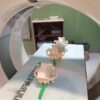New work led by Carnegie’s Zhiyong Wang untangles a complex cellular signaling process that underpins plants’ ability to balance expending energy on growth and defending themselves from pathogens. These findings, published in Nature Plants, show how plants use complex cellular circuits to process information and respond to threats and environmental conditions.
“Plants don’t have brains like us, and they may be fixed in place and unable to flee from predators or pathogens, but don’t feel sorry for them, because they’ve evolved an incredible network of information-processing circuits that enable them to ‘make decisions’ in response to the situations in which they find themselves,” Wang explained.
Joking, he added, “a plant will never sing ‘If I Only Had a Brain,’ because they have evolved this wonder of responsive decision-making instead.”
Higher plants put hundreds of highly specialized sensors, called receptor kinases, on their cell surfaces to monitor the environment and to communicate between cells. Wang’s lab is working to elucidate the molecular circuits that connect these sensors to specific cellular responses, such as growth and immunity. Improving our understanding of how plants make cellular decisions can underpin technological interventions for improving agricultural yields in the face of a warming planet.
In this current work, published in Nature Plants, Wang’s team discovered that two of these sensors use a system of different molecular tags involving a protein that’s shared between their respective communications circuits. This finding links the growth and immune-response loops, advancing our understanding of how plants make their most important decisions.
When a plant senses a threat, it needs to activate communication chains that raise the alarm and tell it to fight off the pathogen. There are two main types of threat-detection mechanisms in plant cells—the ability to recognize distinctive chemical patterns that signify an invader, such as components of a bacterial cell, and the ability to recognize a disruption caused by invading pathogen.
Wang and his research collaborators—including Carnegie’s Chan Ho Park (the lead author), Yang Bi, Nicole Xu, Ruben Shrestha, and Shouling Xu, along with Stanford University’s Jung-gun Kim and Mary Beth Mudgett and colleagues at Chung-Ang University, Hanyang University, and UC San Francisco—traced one enzyme’s role in biochemical signaling pathways for both types of threat recognition.
Called BSU1, the researchers demonstrated that it plays key, but distinct, roles in two pathways—one that promotes growth and the other that raises the plant’s threat alarm system.
One pathway involves a receptor for a member of class of plant hormones called brassinosteroids—which Wang has studied extensively and are crucial to plant growth and development, seed germination, and fertility. The other pathway works through pattern-recognition receptors that specializes in detecting the motile tail of a bacterial invader.
Both of these pathways involve cell surface sensors that, when activated by external signals, chemically tag different proteins to either turn on or turn off their behavior, passing information down a chain of interactions.
The researchers were surprised to discover that BSU1 engages in two entirely separate interaction chains. In the brassinosteroid pathway, BSU1 is involved with the hormone’s growth and development functions. In the pattern-recognition pathway, BSU1 is involved in activating immunity upon threat-detection. BSU1 translates the codes from the different sensors by using different segments of its structure to accept the chemical tag, with each location representing a different message.
Taken together, these results demonstrate the interconnected complexity of growth and immune response. Furthermore, they are a stunning revelation of the way plant’s take in information, process it through biochemical circuits that mimic a binary computer language, and react to environmental conditions to improve their chances of survival.
“Our work demonstrates how a protein like BSU1 can act like a computer chip in processing complex information,” Wang concluded. “As we prepare for a world in which climate change increases stress on important food and biofuel crops, it’s critical that we understand how plants detect and react to external threats.”
More information:
Chan Ho Park et al, Deconvoluting signals downstream of growth and immune receptor kinases by phosphocodes of the BSU1 family phosphatases, Nature Plants (2022). DOI: 10.1038/s41477-022-01167-1
Provided by
Carnegie Institution for Science
Citation:
How plants’ threat-detection mechanisms raise the alarm (2022, June 14)



